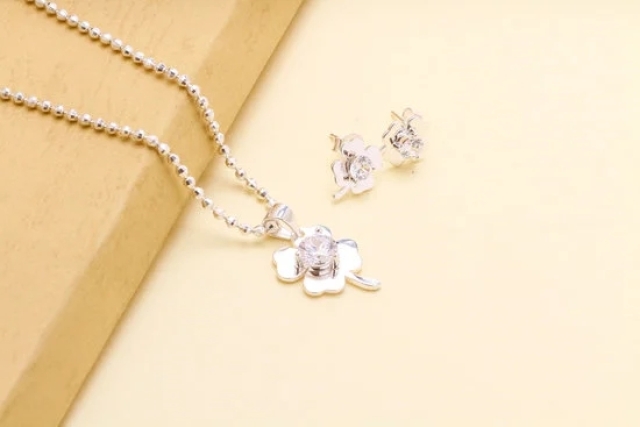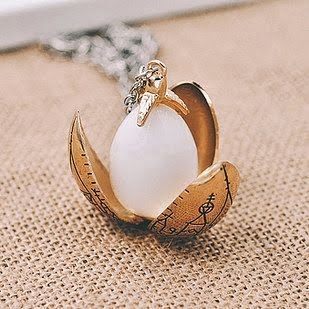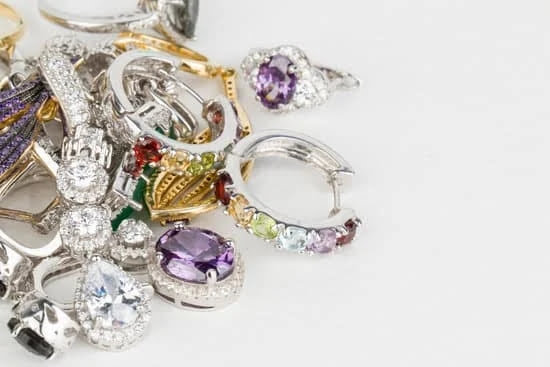Cold connection metal jewelry is defined as jewelry pieces constructed using techniques which do not involve melting the metal. This can range from riveting, to prong setting and more. It is an extremely versatile technique for metalworkers and a great way to get into creating beautifully detailed pieces without having to acquire too much expensive tools or equipment.
Cold Connection Metal Jewelry Techniques One of the most popular techniques used in cold connection metal jewelry is riveting, where flat pieces of metal are connected together with cold connections called rivets that pass through both ends of the piece. This allows the two pieces to stay permanently connected while allowing them to move freely against each other, providing a unique visual texture to a piece of jewelry.
Similarly, wire wrapping techniques can also be used to create intricate designs and patterns along with gem settings like using prongs or bezels for cabochons or faceted stones – all without needing any soldering or welding.
Benefits Of Using Cold Connection Using cold connection techniques has multiple benefits over traditional soldering. Not only does it save time, but it also reduces the number of tools needed, as no expensive torches are required.
This makes this type of jewelry making accessible and easy for entry level jewelers and hobbyists alike as they don’t need to invest in complex and potentially hazardous equipment just to start making their own creations. Also due its nature with permanent fixings unlike snaps or closures there may be less maintenance or un-threading involved when wearing the finished item giving peace of mind when worn daily or going through vigorous activities.
Types of Cold Connection Metal Jewelry and their Uses
Cold connections are a form of metal jewelry-making that eliminates the need for soldering and welding with torches. They are strong, yet flexible metal connections that can be used on their own or in combination with hot connection techniques for greater strength and beauty.
There are several types of cold connections available to metalsmiths including rivets, tabs, split-riveting, hingeing, snap settings and overlays. Each type has its own set of uses and it is important to understand when each technique should be used in order to create the best results.
Riveting is one of the most common forms of cold connection used for connecting two pieces of metal together. A binding post that comes in various sizes is driven into a drilled hole on one side while a corresponding decorative backing post adheres to the other side using pressure.
This durable bond provides both strength and aesthetic appeal to custom jewelry designs. Most rivets come in round or point versions which allow for different levels of customization depending on personal preference and jewelry style requirements.
Tabs are another form of cold connection which tend to create less bulky joins than those created with riveting alone. A tab consists of a sheet metal piece which has smaller holes drilled into either end that correspond with an already existing hole in the desired material/workpiece (usually metal).
By carefully inserting the tab through both holes at once, it creates a permanent connection without requiring gluing as many traditional wet unions do, while providing less bulk than larger rivet heads offer. This makes them ideal for less bulky jewelry items that still require strong bindings like pendants or delicate earrings.
Split-riveting is an extension from basic riveting techniques whereby two thin slits are made parallel to each other near the binding post after it’s been inserted through both workpieces/materials being joined together.
This locks the binding post securely into place so it doesn’t pull out over time as it may due when relying solely on simple pressure tension from regular rivets alone and makes them suitable where extra strong bonds are necessary like necklaces or bracelets pieces with dangling attachments that force more pressure onto the binding posts from general wear and tear movements over time.
Benefits of Cold Connection Metal Jewelry Crafting
Cold connection metal jewelry crafting has become a popular activity in the modern world. It involves techniques that do not require soldering, gluing or hot metal connections. Jewelry makers are able to construct beautiful pieces using rivets, tabs, hinges and other components of cold connection in combination with wire wrapping techniques. The benefits of this type of crafting are numerous.
First and foremost is the cost savings associated with cold connection options for metalsmithing: the tools required for this process are quite a bit less expensive than those used for soldering operations. Cold held connection tools can be easily found at craft stores, hardware stores or ordered online from craft book supplies companies – all very affordable items.
Additionally, corrosion resistance is enhanced by connecting materials without traditional heat sources – making them able to withstand more wear and tear through everyday use. This particular benefit makes cold connection an excellent option for jewelry makers looking to make rugged or everyday-wear pieces that can last for years to come.
Liability related concerns are also decreased when using cold connection options as opposed to conventional hot joining processes such as soldering or welding jewelry work pieces together – if there were to be an issue with the finished piece it would be much easier to repair due to the absence of a heat source utilized during its production.
This also provides additional peace of mind when designing and constructing new large scale works – such as individual settings around stones and displaying multiple movements within a single item – without having the fear that any part might fail or become damaged after heating up during usage or general wear and tear.
Finally, while it’s possible cold-made designs could take longer than their hot-connected counterparts – particularly complex items that feature intricate shapes and details – they often provide faster time frames in production since no extra time is needed before bringing individual parts of one project together (as they have already been pre-made).
Furthermore, completing projects by connecting several components together without creating bulky solder joints does create finer details on finished work (particularly end results with more delicate elements).
These are just some of the benefits associated with cold connection metal jewelry crafting.
Techniques for Creating Cold Connection Metal Jewelry
Cold connection is a jewelry making technique that involves connecting metal components without the use of soldering or other heating processes. This method makes it possible to create intricate jewelry designs with beautiful detail without having to worry about melting elements together. Cold connection is especially useful for involving other materials such as wiring, mesh and cloth into metal pieces.
Using Crimp Beads for Cold Connections
Crimp beads are one of the most popular techniques used in cold connection metal jewelry making. These round, disc-like beads come in a variety of sizes and finishes. When crimped shut using pliers, they hold two strands of wire together securely. Crimp beads make it easy to attach bead charms, pendants and even pieces of chain or leather cord to any length of wire creating a strong and secure connection.
Split Rings
Split rings are another type of cold connection commonly used in jewelry making. These items look like small key rings are made from thin metal wires that have been wound together in circles with cut edges on either side. Split rings are ideal for attaching charms, beads and pendants which can be woven through the opening allowing you to create unique jewelry designs without having to crimp or solder anything together.
Wire Wrapping
Wire wrapping is a technique which uses various wraps and coils to secure elements together without any heat or gluing agents. Using simple hand tools, the piece conductor creates intricate patterns winding wire around the components he/she wants connected. With wire wrapping you can connect just about any type of material including fabric, crystal, stones and glass resins – making it a versatile choice when creating long lasting cold connections for your metal jewelry designs.
Step-by-Step Guide for Crafting Cold Connection Metal Jewelry
Cold connection metal jewelry is a versatile art form and making it can be fun and easy. With this step-by-step guide, you can craft beautiful, one-of-a-kind pieces with minimal effort. Let’s get started.
The first step in crafting cold connection Jewelry is to gather your materials. You will need metal for the base of your piece(s) as well as for each additional element that you choose to add to your design.
Ideally, metals such as sterling silver or copper will work best as they create stronger connections than plated metals do. You will also want to stock up on tools like mallets, hammers, rivets, eyelets and wire snips for forming your individual components into finished pieces.
Before beginning the assembly process of your piece(s), it is important to make sure that all of your materials are properly cleaned and prepped. This step ensures that everything is at its most functional state before continuing on with the project – plus it looks better too.
Make sure to use a degreaser or soft cloth and warm water to effectively clean off any dirt or oils from the material’s surface. Once completed, you are ready to move onto fabricating the individual elements of your design together.
Now comes the fun part – assembling the components into a cohesive piece. Depending on what you have chosen for your piece(s), start by cutting out shapes from sheets of metal using wire cutters or saw blades if necessary. If rivets are used in your design, don’t forget to drill holes into each layer before hammering them together.
From there you may consider adding texture throughout with stamping tools or low power equipment such as a flex shaft for intricate details within the layers of your project. Finally, put your finishing touches on by polishing up each element with either steel wool or sandpaper giving them a professional finish not just for look but longevity too. Now enjoy wearings pieces that reflect only you.
List of Essential Supplies for Cold Connection Metal Jewelry Crafting
- Jewelry Metals: A key element in cold connection metal jewelry is using metal, such as silver and copper. It can come in flat sheets or rods and can be formed into various shapes depending on your project.
- Cutting Tools: Cold connection metal jewelry often requires cutting tools to precisely shape the materials. Buy a table-top hand shear or purchase a clamping tool with alternate blades for this purpose.
- Joining Materials: You must use strong materials to securely tie together jewelry components. Jeweler’s epoxy and two-part solders are two of the most common ways to join jewelry elements.
- Hammering Tools: Each joining method will require different hammering tools. Examples of these include chasing hammers, ball pein hammers, cross peen hammers, planishing hammers, forming hammers, and mallets.
- Files & Rasp: Finishing touches on pieces will require small metal files and rasps to make the smooth edges required for cold connection techniques.
- Sand Paper & Sanding Blocks: To buff out any imperfections or prepare pieces for soldering you’ll need sandpaper of various ranges (ie from extra fine to coarse grains). A set of sanding blocks makes it easier to manipulate small parts than paper alone.
- Metallizing Colors/Patina/Ganoksin Solutions: If you want to add colour and texture to the final piece then adding patinas may be an option. Patinas add colour or texture by reacting with specific metals over time due their interaction with oxygen or other chemicals (ganoksin solutions).
Cold connection Metal Jewelry also needs some special supplies for texturing including chasing tools, automatic shears, ring stretchers, rectangle mandrels/benders, disc cutters and bracelet pliers. For this purpose a jeweler usually requires files made up of diamond points in varying sizes – small diamond point files allow one to create detailed textures that are impossible with other tools. Chasing tools also help emphasize designs as well as texture individual links in multi-stranded pieces.
Rotary disc cutters have adjustable stops that make cutting circles easy while rectangle mandrels help craft rings of various sizes quickly and accurately without marring the surface finish. Finally bracelet pliers help flatten and bend bracelets so they fit properly around the wrist comfortably.
Safety Considerations when Working with Cold Connection Metal Jewelry
Cold connection metal jewelry is a rewarding craft, but it is important to remember the fundamental safety considerations so that your DIY projects do not become injuries. To ensure safe jewelry making, it is essential to keep the following in mind:
- Always read and understand all manufacturer instructions and warnings. This ensures that you know how to properly use the materials, tools, and equipment provided.
- Wear the appropriate clothing when working with metal jewelry. Safety goggles, gloves, and aprons are all necessary for protecting yourself from accidental cuts or burns.
- Inspect any cold connection tools before each use in order to ensure they are functioning correctly or if parts need replacing due to wear-and-tear resulting from extensive use.
- Work on a flat surface where appropriate workspace lighting is available; this prevents misplacing tools/materials while Cold Connection Metal Jewelry crafting.
- Ensure any tools with sharp edges such as pliers, cutters, nippers, etc., are placed away whenever possible. This way radiation of light against these sharp objects can be prevented.
It is also important to maintain good hygiene when working with metal jewelry; washing hands thoroughly after handling tools or materials will help avoid transferring dirt or other contaminants onto finished products and prevent cross-contamination between different pieces of jewellery being worked on at once. Regular cleaning of work surfaces should also be carried out in order to minimize the amount of dust from previous works which lingers around during new projects.
To conclude it is essential that all safety guidelines are followed while crafting metal jewelry with cold connections in order ensure an enjoyable crafting experience as opposed to worrying over accidents happening along the journey.
Conclusion
Cold connection metal jewelry is a versatile way to create one-of-a-kind pieces. With no soldering required, the possibilities are endless. Cold connection can be used for traditional techniques like riveting and tab setting or outside the box approaches like creating your own textured surfaces by dotting or sanding and textures with findings like strings of beads or eggs.
You can also explore unorthodox ideas like using everyday objects earned from nature such as shells and stars to be incorporated into your artmaking process.
It’s truly limitless: you can use any kind of material that will not melt from excessive heat to add beautiful character to your creations, whether it be altered paper, gems, crystals, leather, wire, beads, etc The act of cold connection allows you to move beyond the limitations of solder so that you are free to express yourself as creatively as you wish.
Cold connection metal jewelry gives design and craft enthusiasts wonderful options when constructing their projects. Working without a torch opens up a world of possibilities as craftsmen have more control over both the look and feel of each piece.
Thanks to riveting systems that don’t require excess heat, heavy duty joinery with specialty connections such as eyelets and cup washers are achievable on even thinner metals. Leverback earrings are easy enough for inexperienced jewelers; likewise bangles with stones set in place with tube settings become easier once hot soldering is taken out of the equation.
There is no right or wrong when it comes to cold connected metal jewelry making. Experimenting becomes part of the journey while giving artists the freedom they need to push their creative boundaries without fear of failure.
It’s all about exploring your own style and letting your imagination run wild. From subtle detail work involving tiny parts created out of wire or string to bold statement pieces imbued with rich textures crafted from fine metals – cold connection has given us all an exciting opportunity to turn functional everyday items into wearable works of art.

Welcome to my jewelry blog! My name is Sarah and I am the owner of this blog.
I love making jewelry and sharing my creations with others.
So whether you’re someone who loves wearing jewelry yourself or simply enjoys learning about it, be sure to check out my blog for insightful posts on everything related to this exciting topic!





